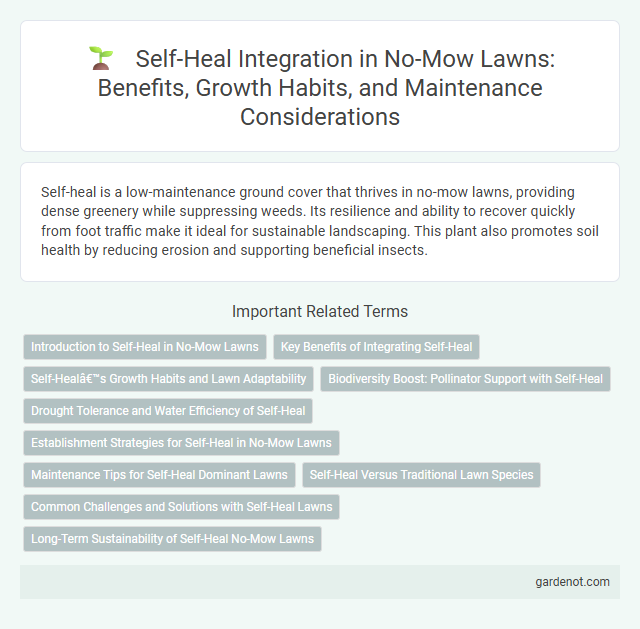Self-heal is a low-maintenance ground cover that thrives in no-mow lawns, providing dense greenery while suppressing weeds. Its resilience and ability to recover quickly from foot traffic make it ideal for sustainable landscaping. This plant also promotes soil health by reducing erosion and supporting beneficial insects.
Introduction to Self-Heal in No-Mow Lawns
Self-heal (Prunella vulgaris) is a hardy, low-growing perennial commonly found in no-mow lawns due to its ability to thrive without frequent cutting. This groundcover enhances lawn resilience by repairing soil erosion and suppressing weeds with its dense growth habit. Its vibrant purple flowers not only add aesthetic value but also attract pollinators, promoting biodiversity in eco-friendly lawn care.
Key Benefits of Integrating Self-Heal
Self-heal (Prunella vulgaris) enhances no-mow lawns by providing durable ground cover that reduces soil erosion and suppresses weed growth naturally. Its dense foliage improves lawn resilience and promotes biodiversity by attracting pollinators such as bees and butterflies. Integrating self-heal supports low-maintenance landscapes, minimizing water usage and mowing frequency while maintaining aesthetic appeal.
Self-Heal’s Growth Habits and Lawn Adaptability
Self-Heal (Prunella vulgaris) thrives in diverse soil types, exhibiting vigorous ground cover with rapid horizontal spreading through stolons. Its low-growing habit and deep root system enable resilience against foot traffic, making it an excellent choice for no-mow lawns that require minimal maintenance. Adaptable to both sunny and partially shaded environments, Self-Heal enhances lawn biodiversity while maintaining consistent green coverage without regular mowing.
Biodiversity Boost: Pollinator Support with Self-Heal
Self-heal (Prunella vulgaris) enhances no-mow lawns by providing vital pollen and nectar resources that support a wide range of pollinators, including bees and butterflies. Its dense growth habit improves soil health and biodiversity, promoting a balanced ecosystem. Integrating self-heal supports pollinator populations and contributes to a resilient, wildlife-friendly lawn environment.
Drought Tolerance and Water Efficiency of Self-Heal
Self-heal (Prunella vulgaris) exhibits exceptional drought tolerance, thriving in low-water conditions by efficiently conserving moisture within its leaves. This resilience makes it an ideal component of no-mow lawns, reducing the need for frequent irrigation and promoting water conservation. Its deep root system enhances soil stability and supports sustained growth during dry periods, optimizing water efficiency in drought-prone environments.
Establishment Strategies for Self-Heal in No-Mow Lawns
Self-heal (Prunella vulgaris) thrives in no-mow lawns by minimizing soil disturbance and allowing natural spreading through stolons and seed dispersal. Establishment strategies include overseeding during early spring or fall, ensuring consistent moisture to promote root development, and reducing competition from aggressive grasses. Incorporating organic matter enhances soil health, supporting robust self-heal growth and resilience in low-maintenance lawn ecosystems.
Maintenance Tips for Self-Heal Dominant Lawns
Self-heal (Prunella vulgaris) thrives with minimal mowing, ideally kept at a height of 2 to 3 inches to encourage dense coverage and prevent weed invasion. Regularly remove debris and monitor soil moisture to maintain healthy growth, ensuring the lawn isn't waterlogged or excessively dry. Applying a balanced, slow-release fertilizer in early spring supports vigorous healing and resilience throughout the growing season.
Self-Heal Versus Traditional Lawn Species
Self-Heal (Prunella vulgaris) offers superior drought tolerance and nutrient efficiency compared to traditional lawn grasses like Kentucky bluegrass or fescue, reducing water and fertilizer use significantly. This low-maintenance ground cover also promotes biodiversity by attracting pollinators and providing natural weed suppression, enhancing lawn health without chemical inputs. Its rapid spreading capability ensures dense, resilient coverage, minimizing bare spots and soil erosion commonly seen in conventional turfgrass.
Common Challenges and Solutions with Self-Heal Lawns
Self-heal (Prunella vulgaris) offers a resilient solution to common no-mow lawn challenges such as patchy growth, soil compaction, and weed invasion. Its ability to thrive in various soil types and recover quickly from foot traffic promotes uniform ground cover, reducing maintenance needs. Integrating self-heal into no-mow lawns enhances biodiversity while providing natural erosion control and improving soil health through its deep rooting system.
Long-Term Sustainability of Self-Heal No-Mow Lawns
Self-heal (Prunella vulgaris) thrives in no-mow lawns, promoting long-term sustainability through its deep root system that enhances soil health and moisture retention. This resilient groundcover reduces the need for fertilizers and irrigation, supporting eco-friendly lawn management. Its natural ability to suppress weeds further contributes to a durable, low-maintenance lawn ecosystem.
Self-heal Infographic

 gardenot.com
gardenot.com